|
|
| |
| |
|
|
|
|
|
|
|
|
| |
| |
| |
| |
| |
| |
| |
| |
| |
| |
|




| |
| |
|
Tell them you found it on anvilfire.com!
|
Blacksmithing and metalworking questions answered.
|
Blacksmithing and Metalworking Tools Historical Preservation.
|
|
|
Soap-Box Derby Days
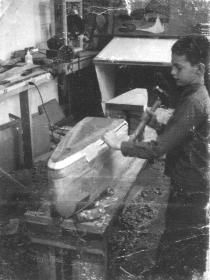
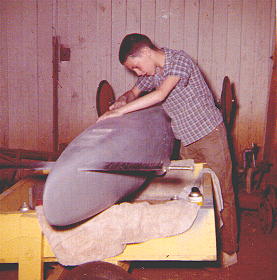
I Started building this car in 1961. My father insisted I do all the work.
I learned to use a sabre saw, hammer and chisel, drill press, lathe, fibre glass, epoxy, body putty and lacquer.
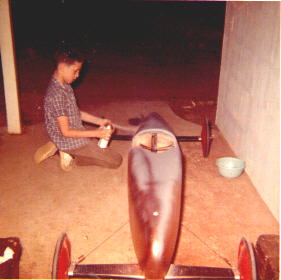
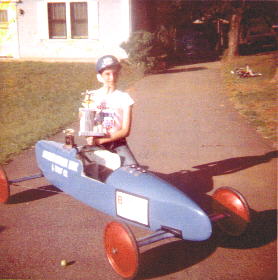
I ran the same car two years taking second place twice.
The second year the car was improved a little and had a real first class hand rubbed lacquer paint job.
My third year car (not shown) was very similar and painted blue again.
By now I had my own ideas about how to do things and came up with some unique solutions.
One was to replace epoxy with body putty for applying fibre glass.
The other was to slant the front and back of the cockpit cutout forward at the bottom.
This closed up the big air trap where the drivers back fit into the car.
Nothing in the rules said it had to be rectangular!
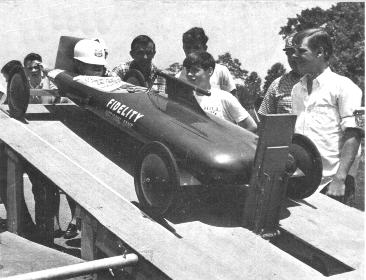 My final car was the first of its kind, a "recliner" and started a revolution in soap box racer design.
This was my own design with some inspiration from the Flash Gorden comic strip!
No one had ever built a recliner before this.
In the following years this design dominated the SBD and is still one of the kit designs.
My final car was the first of its kind, a "recliner" and started a revolution in soap box racer design.
This was my own design with some inspiration from the Flash Gorden comic strip!
No one had ever built a recliner before this.
In the following years this design dominated the SBD and is still one of the kit designs.
The car was laminated from 32 layers of 1/4" masonite.
However, when we finished laminating the two halves and put them together for a test fit, my feet had grown several shoe sizes and I didn't fit!
I had to add 2" of height to the front end of the mathematically perfectly elliptical body!
Father and Son:
Like many projects the boy was supposed build the car with his father's help. .
My Dad insisted that I do all the work.
He taught me how to do the layout, cut the boards, use chisel and plane, operate a lathe, drill and tap holes, paint with a spray gun and sand and polish paint.
Building my cars seemed to take forever and went in spurts. But I did all the physical work.
This was usually not the case with other father's and sons. The problem was most cars did not turn out like mine.
Most of the parent built cars were what you imagined when you said "soap box" racer. . . They were long coffin like boxes on wheels.
Mine and a few of the parent built cars often lead to complaints of cheating since the racers were supposed to be built by the boys.
There was an award for the 10 best built cars but it came with a caveat.
Those in the 10 best had to take a test, making a sculptural piece from sawed and laminated pine boards with a quarter round shape at one end and coming to a point on the other.
This was supposed to represent a section of the car. I was in the 10 best every year including the first.
The test was held in the local high school shop with race officials and parents attending - but they could only advise, not touch.
I was 11 years old at the time.
-
Step one was to layout the four 3/4" pine boards to be cut.
I stacked mine up, drew a half round on one end and a graceful curve on the long side.
Each line was then extended vertically to the place to cut.
Then I drew a curve on each board from the end line to the point line.
Meanwhile everyone else was trying to figure out how to do the layout or use bent boards to draw the curve. . many were erasing marks that did not meet muster.
-
The next step was to cut the boards.
I was the only one that came prepared with my own tools including a Sabre saw so I immediately went to cutting.
This was about a one minute job.
Meanwhile the few who had done their layout were waiting in line for an adult to cut their boards on the shop bandsaw.
- Step three was to glue up the boards.
Since time was a factor (the test had to be completed in one evening), glue was applied and finishing nails were also used.
A lot of nails were needed since we were not waiting for the glue to dry.
Location was by guestimation.
If they were in the area to be cut they would ding the tools and need to be driven in farther.
I only misjudged a couple.
- Step four was the carving.
I knocked off a couple of the larger corners with a big flat chisel I had been using for years.
Most of the others had to use the school's tools which they were unfamiliar with (if familiar with using a chisel at all - most were not).
I then changed to a 16" Jack plane.
Most people think of a plane for making flat surfaces but they make wonderful convex curves without great danger of undercut.
Chiseling and planing took about 10 minutes. Then I changed to a rasp to blend the curves and then sandpaper.
-
Testing was to be from 7 PM to 11 PM - 4 hours.
I was finished in less than an hour. Many were still laying out their boards or waiting for them to be cut (the adult on the band saw was not very proficient with the machine).
At this point there were several boys in trouble. One was the oldest (15).
The son of a Cabinet Maker and eventual winner of the race.
Even if he had worked on his car it was all flat surfaces carefully fitted.
He was still waiting to get his boards sawed and asked me if he could use my saw.
"Sure", I said. I looked at his layout and it was obvious that he could not draw and had no eye for curves.
I offered some suggestions to add some curve to the nearly straight lines.
I had to help him with the clamps and coach his sawing.
When the parts were cut he asked me, "What next?".
After gluing it was obvious that chiseling was not in his skill set and neither was rolling a plane along a curve.
He spent the next couple hours making the shape with a rasp.
He finished about midnight and a few others were still working.
The officials had extended the hours due to the hold up on the band saw.
I went home feeling good about having helped someone (I taught another boy more in a couple hours than his father had in years).
It was a little sad knowing this boy and others had learned nothing from building their cars.
Now I wonder what the officials would have done.
Nobody failed the test - but many should have.
I still have my original test piece.
A couple years later I made another out of chip board before building my third car to see how it carved.
It worked OK but all the end grain is hard on tools and the surface ends up very porous.
It has walked off. Maybe I will make another one day to have a pair.
VIDEO Soap Box Derby Documentary 1936
While this video was in the early days of the Derby it had not changed much when I was in it.
The biggest changes when I raced (other than the clothes people wore) was the use of standard wheels and axles, maximum weight of 250 pounds, maximum length of 80 inches.
The race we attended in Akron, OH in 1962 was very similar to the one in this film.
The modern Soap Box Derby has become so namby-pamby and controlled (all cars are kits put together like flat ship furniture - no cutting, sawing, drilling. . . ) that a world wide
Illegal Gravity Racer Federation has sprung up with a no-holds bared approach. Its not for children as its illegal and dangerous.
However, ONE of their rules is that brakes cannot be ground drag pads which is what the Official Soap Box Derby has always required and DO NOT WORK. . .
Since the rise of loosely organized almost no rules gravity racing more people have taken part in the sport in the past few decades than in the nearly 80 years of the official Soap Box Derby.
Sponsors like Red Bull have run organized races and the X-Games have Extreme Gravity Racing.
Gravity races are held world wide.
A few localities have organized races where even very young children can take part.
So while the AASBD has become the least competitive, lowest common denominator children's event . . . the rest of the world has found the FUN and creativity in the sport.
Return to biography of Jock Dempsey
Copyright (c) 2000, 2015 Jock Dempsey
|
|
|
|


Soap-Box Derby Days
The car was laminated from 32 layers of 1/4" masonite. However, when we finished laminating the two halves and put them together for a test fit, my feet had grown several shoe sizes and I didn't fit! I had to add 2" of height to the front end of the mathematically perfectly elliptical body!
Father and Son:
Like many projects the boy was supposed build the car with his father's help. . My Dad insisted that I do all the work. He taught me how to do the layout, cut the boards, use chisel and plane, operate a lathe, drill and tap holes, paint with a spray gun and sand and polish paint. Building my cars seemed to take forever and went in spurts. But I did all the physical work. This was usually not the case with other father's and sons. The problem was most cars did not turn out like mine. Most of the parent built cars were what you imagined when you said "soap box" racer. . . They were long coffin like boxes on wheels.Mine and a few of the parent built cars often lead to complaints of cheating since the racers were supposed to be built by the boys. There was an award for the 10 best built cars but it came with a caveat. Those in the 10 best had to take a test, making a sculptural piece from sawed and laminated pine boards with a quarter round shape at one end and coming to a point on the other. This was supposed to represent a section of the car. I was in the 10 best every year including the first.
The test was held in the local high school shop with race officials and parents attending - but they could only advise, not touch. I was 11 years old at the time.
-
Step one was to layout the four 3/4" pine boards to be cut.
I stacked mine up, drew a half round on one end and a graceful curve on the long side.
Each line was then extended vertically to the place to cut.
Then I drew a curve on each board from the end line to the point line.
Meanwhile everyone else was trying to figure out how to do the layout or use bent boards to draw the curve. . many were erasing marks that did not meet muster.
-
The next step was to cut the boards.
I was the only one that came prepared with my own tools including a Sabre saw so I immediately went to cutting.
This was about a one minute job.
Meanwhile the few who had done their layout were waiting in line for an adult to cut their boards on the shop bandsaw.
- Step three was to glue up the boards.
Since time was a factor (the test had to be completed in one evening), glue was applied and finishing nails were also used.
A lot of nails were needed since we were not waiting for the glue to dry.
Location was by guestimation.
If they were in the area to be cut they would ding the tools and need to be driven in farther.
I only misjudged a couple.
- Step four was the carving.
I knocked off a couple of the larger corners with a big flat chisel I had been using for years.
Most of the others had to use the school's tools which they were unfamiliar with (if familiar with using a chisel at all - most were not).
I then changed to a 16" Jack plane.
Most people think of a plane for making flat surfaces but they make wonderful convex curves without great danger of undercut.
Chiseling and planing took about 10 minutes. Then I changed to a rasp to blend the curves and then sandpaper.
-
Testing was to be from 7 PM to 11 PM - 4 hours.
I was finished in less than an hour. Many were still laying out their boards or waiting for them to be cut (the adult on the band saw was not very proficient with the machine).
At this point there were several boys in trouble. One was the oldest (15). The son of a Cabinet Maker and eventual winner of the race. Even if he had worked on his car it was all flat surfaces carefully fitted. He was still waiting to get his boards sawed and asked me if he could use my saw. "Sure", I said. I looked at his layout and it was obvious that he could not draw and had no eye for curves. I offered some suggestions to add some curve to the nearly straight lines. I had to help him with the clamps and coach his sawing. When the parts were cut he asked me, "What next?". After gluing it was obvious that chiseling was not in his skill set and neither was rolling a plane along a curve. He spent the next couple hours making the shape with a rasp. He finished about midnight and a few others were still working. The officials had extended the hours due to the hold up on the band saw.I went home feeling good about having helped someone (I taught another boy more in a couple hours than his father had in years). It was a little sad knowing this boy and others had learned nothing from building their cars. Now I wonder what the officials would have done. Nobody failed the test - but many should have.
I still have my original test piece. A couple years later I made another out of chip board before building my third car to see how it carved. It worked OK but all the end grain is hard on tools and the surface ends up very porous. It has walked off. Maybe I will make another one day to have a pair.
VIDEO Soap Box Derby Documentary 1936
While this video was in the early days of the Derby it had not changed much when I was in it. The biggest changes when I raced (other than the clothes people wore) was the use of standard wheels and axles, maximum weight of 250 pounds, maximum length of 80 inches. The race we attended in Akron, OH in 1962 was very similar to the one in this film.
The modern Soap Box Derby has become so namby-pamby and controlled (all cars are kits put together like flat ship furniture - no cutting, sawing, drilling. . . ) that a world wide Illegal Gravity Racer Federation has sprung up with a no-holds bared approach. Its not for children as its illegal and dangerous. However, ONE of their rules is that brakes cannot be ground drag pads which is what the Official Soap Box Derby has always required and DO NOT WORK. . .
Since the rise of loosely organized almost no rules gravity racing more people have taken part in the sport in the past few decades than in the nearly 80 years of the official Soap Box Derby. Sponsors like Red Bull have run organized races and the X-Games have Extreme Gravity Racing. Gravity races are held world wide. A few localities have organized races where even very young children can take part. So while the AASBD has become the least competitive, lowest common denominator children's event . . . the rest of the world has found the FUN and creativity in the sport.
Copyright (c) 2000, 2015 Jock Dempsey